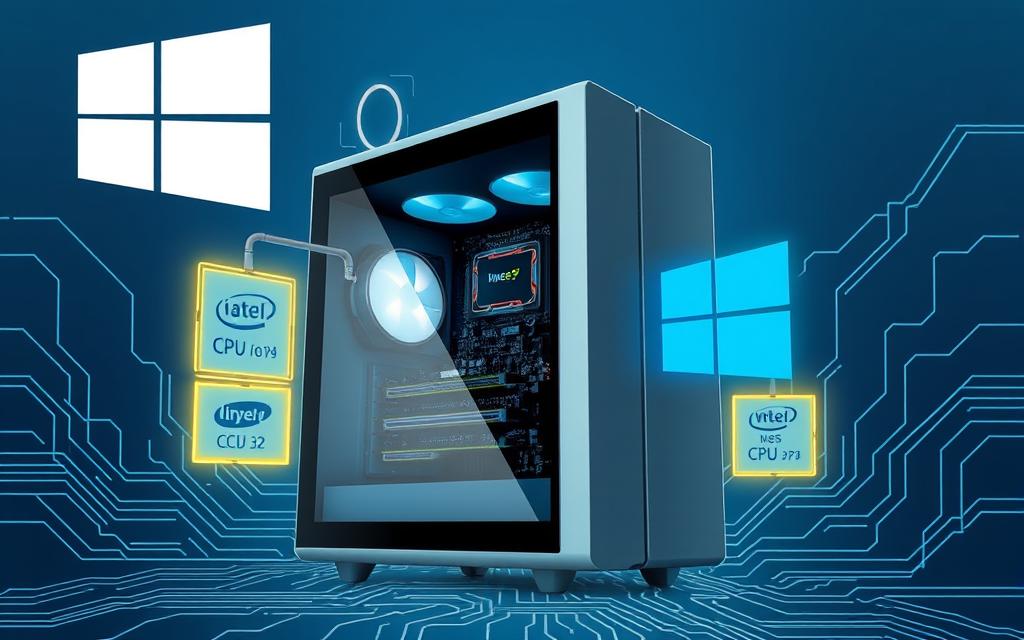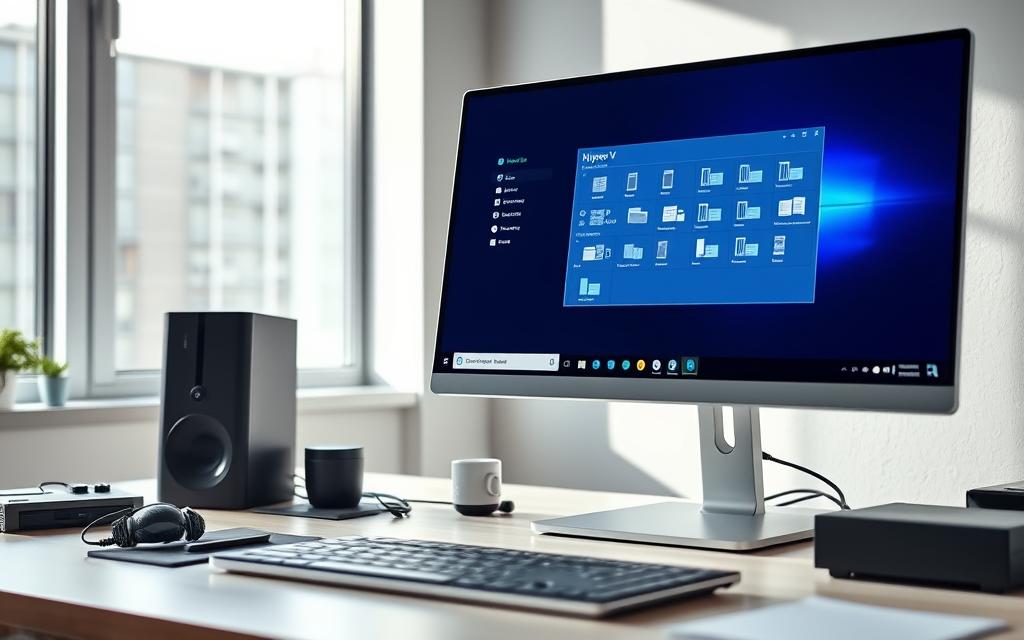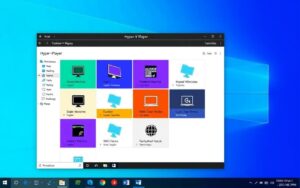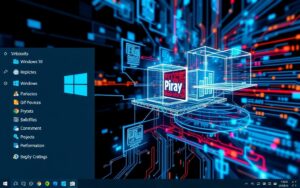Table of Contents
Welcome to this thorough guide on enabling Hyper-V in Windows 10. We’ll show you how to activate and set up this powerful Microsoft virtualisation feature. Doing so allows you to make and control virtual machines with ease.
Hyper-V is an optional feature in Windows 10, eliminating the need for extra downloads. It’s perfect for those wanting to dive into Windows 10 virtualisation. Just follow our detailed instructions to unlock virtualisation’s full potential smoothly.
We’ll also touch on virtualisation’s key points, highlighting Hyper-V’s value for both personal and work use. For more on this topic, see this useful link.
Introduction to Hyper-V on Windows 10
Virtualisation has changed the way we use computers. Hyper-V, developed by Microsoft, is a key player in this change. It lets you create and manage virtual machines on Windows 10. This adds great flexibility to your computing, which is great for developers and computer buffs.
What is Hyper-V?
Hyper-V is a technology that allows you to run several operating systems at the same time on one computer. It started with Windows 8, but Windows 10 brought significant improvements. Hyper-V supports many operating systems like Linux, FreeBSD, and several Windows versions. It’s easy to set up and manage your virtual machines. This makes your work smoother and helps you use your resources better.
Benefits of Using Hyper-V
The benefits of Hyper-V touch many parts of computing. Here are some main perks:
- Efficiency in Resource Management: Hyper-V lets multiple virtual machines share one hardware. This improves system performance.
- Simultaneous OS Operations: You can run various operating systems at the same time. This is great for testing and development.
- Enhanced Development Environments: Developers can make isolated areas for testing apps. This minimises the risk to the main system.
- Cloud Services Platform: Hyper-V offers a strong platform for cloud services. This is crucial in today’s digital world.
Knowing the virtualisation benefits of Windows 10 shows how Hyper-V can improve your daily tasks. Hyper-V integrates lots of features and supports hardware virtualisation. This makes it a solid choice for both personal and work computing needs.
System Requirements for Hyper-V
Before setting up Hyper-V, it’s vital to check if your system can handle it. Making sure your system fits the specs is key for top performance.
Supported Windows Versions
Hyper-V works with several Windows operating systems. The list of supported Windows versions includes:
- Windows 8.1 Pro and Enterprise
- Windows 10 Pro and Enterprise
- Windows 11 Pro and Enterprise
- Windows Server 2008 and later versions
But remember, Hyper-V won’t work on Windows Home editions. This point limits where it can be used.
Hardware Requirements for Hyper-V
For Hyper-V to run smoothly, your hardware must meet certain criteria. These are the specs needed:
| Requirement | Description |
|---|---|
| Processor | 64-bit processor with Second Level Address Translation (SLAT) |
| RAM | Minimum of 4 GB (8 GB recommended for optimal performance) |
| Virtualisation Support | Enabled in BIOS/UEFI |
| CPU Features | Support for VM Monitor Mode Extension and Hardware-enforced Data Execution Prevention (DEP) |
Meeting these requirements ensures you can use Hyper-V effectively. Proper setup allows benefits like multiple test environments and improved security.

Step-by-Step Enabling Hyper-V for Use on Windows 10
To turn on Hyper-V on Windows 10, users access powerful features for running virtual machines. Various Hyper-V enable methods like using the Control Panel, PowerShell, or DISM are available. You can pick the method that suits your comfort level and technical knowledge best.
Enabling Hyper-V via Control Panel
The simplest way to enable Hyper-V is through the Control Panel’s Windows Features menu. This approach is great for those who prefer not to use command lines. Here’s how you do it:
- Open the Control Panel.
- Select “Programs”.
- Click on “Programs and Features”.
- On the left, find and click “Turn Windows features on or off”.
- In the features list, tick the box next to Hyper-V and any relevant sub-features.
- Click “OK” and wait for it to install.
Using PowerShell to Enable Hyper-V
If you’re good with command line tools, PowerShell Hyper-V installation is efficient. Here’s what to do:
- Open PowerShell as an Admin.
- Run the command:
Enable-WindowsOptionalFeature -Online -FeatureName Microsoft-Hyper-V -All. - Watch the text format progress.
This way suits those who oversee multiple installations or like scripting.
Alternative Method: Using DISM Tool
The dism tool Windows is another way to activate Hyper-V. It’s great for those wanting detailed control over the installation. Here’s how to use DISM:
- Open Command Prompt as an Admin.
- Execute:
DISM /Online /Enable-Feature /All /FeatureName:Microsoft-Hyper-V. - Let it finish, then restart your computer.
This method gives detailed installation control, preferred by many experts.
| Method | Ease of Use | Best For |
|---|---|---|
| Control Panel | Very Easy | Beginner Users |
| PowerShell | Moderate | Advanced Users |
| DISM Tool | Advanced | Technical Users |
Choosing the best method depends on what you prefer and your tech skills. Any of these methods will effectively turn on Hyper-V. This lets you use great virtualisation tools on your Windows 10 system.
Conclusion
The enabling Hyper-V overview is key for anyone wanting to use virtualisation tech in Windows 10. It guides users through unlocking Hyper-V’s potential for better resource management and productivity. Remember, Windows 10 Professional and Enterprise editions include Hyper-V, but the Home edition requires a manual setup.
For the best performance with Hyper-V, having at least 8GB of RAM is advised. Today, most hardware supports virtualisation, so nearly everyone can improve their systems. If installation issues arise, troubleshooting guides are very helpful.
Once Hyper-V is up and running, exploring its wide range of features is the next step. This includes setting up virtual machines and managing a VDI for easier desktop management. Delving into Hyper-V allows users to fully leverage modern computing tech.
FAQ
What is Hyper-V?
Hyper-V is a built-in feature in Windows 10. It lets you create virtual machines on your PC. This boosts your computer’s ability to do tasks like testing, developing software, and using cloud services.
How can I enable Hyper-V on my Windows 10 computer?
To turn on Hyper-V, you can go through the Control Panel, use PowerShell, or use the DISM tool. You can pick the Hyper-V features you want and install them easily.
What are the system requirements to run Hyper-V?
You’ll need Windows 10 Pro, Enterprise, or Windows 11 Pro, Enterprise to use Hyper-V. Your PC must have a 64-bit processor with SLAT, support for VM Monitor Mode Extension, and at least 4 GB of RAM.
Can I install Hyper-V on Windows 10 Home Edition?
No, Hyper-V won’t work on Windows 10 Home Edition. It’s available for the Pro and Enterprise editions of Windows 10 and 11.
What are the benefits of using Hyper-V?
Hyper-V improves how your computer manages resources. It lets you run several operating systems at once. It’s also great for testing and developing new software. And it’s a solid choice for cloud services. All these features boost your productivity.
What is the easiest method to enable Hyper-V?
The easiest way depends on you. But the Control Panel might be simpler for those not used to command lines. Or, you can use PowerShell for a quick setup.
What happens if my system does not meet Hyper-V requirements?
If your PC doesn’t meet the requirements, Hyper-V won’t work well. You might have trouble with virtualisation features.
Where can I find help if I encounter issues with Hyper-V?
For any Hyper-V problems, Microsoft’s support, online forums, or the Windows community can offer help. They provide guidance and troubleshooting advice.









